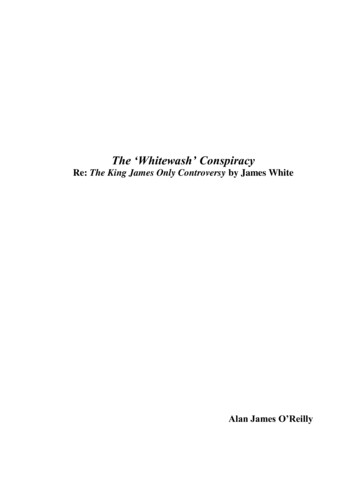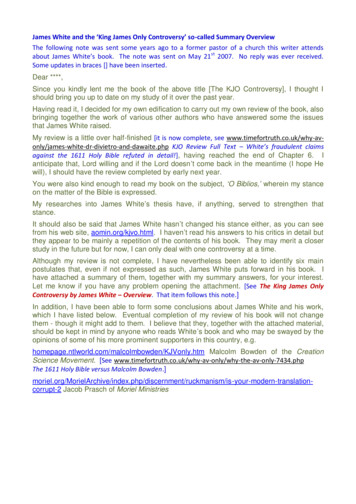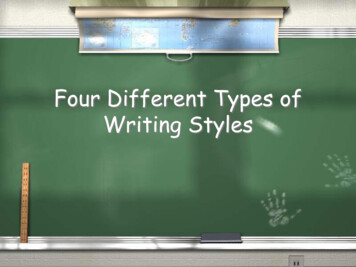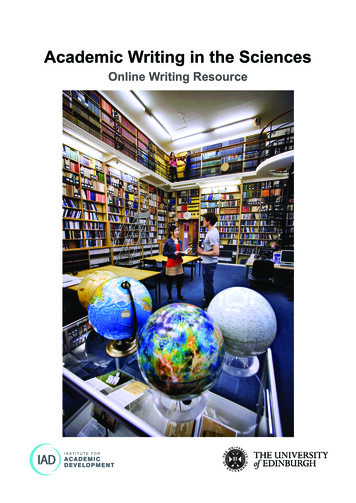
Transcription
1
Writing in the Sciences
Scientific Writing Communicate scientific research to peers Scientific journals disseminate information Generally rigid in format and presentation Scrutinised and reviewed by scientific peers3
Assessment – Scientific ReportLearn scientific skills:– Conduct scientific research project– Analyse data– Report findings in accepted scientific journalstructure– Review peer articles in a critical manner– Address peer review of your paper4
Scientific Writing Style Third personThe number of individual Kalahari tree skinkswere countedor First personWe counted the number of individual Kalaharitree skinks Be consistent!!!5
Scientific Writing Style Past tense– We counted the number of individual Kalaharitree skinks– The number of individual Kalahari tree skinkswere counted6
Scientific Writing Style7
Scientific Writing Style8
Scientific Report - Structure1. Title2. Abstract3. Introduction4. Methods5. Results6. Discussion/Conclusion7. References9
Title Concise and informative Short accurate description of the main point/emphasis of work Should reflect exactly what you did and not be vague Include any names of species studied – give common namefollowed by scientific name Only the first letter of the first word and proper nounscapitalised10
Title The reader should be able to decide if the information in yourreport is relevant from your title“Greenhouse experiment.” – not sufficiently informative“A simulation of the effects of carbon dioxide on atmospherictemperature and ocean acidity.” 11
TitleShort butdescriptive title ofwhat wasinvestigatedcommon namespecies name in italics –sometimes in brackets(depends on the journal)12
Abstract Summary of whole paper – One concise paragraph(about 150-200 words or approximately 10% of the whole text) Highlighting– The main reason for the study– Methods employed– Principal results– Major conclusions*Does not contain references13
Abstract Gives the reader a quick overview of thewhole report Write the abstract last – you will have aclearer picture of findings and conclusions14
What they did15
Why we should payattention16
Results – even ifunexpected or notsignificant17
Key conclusions andrecommendations – futureconsiderations can be included18
19
Background& whyResultsDiscussionConclusion20
Introduction Provides scientific background information Establishes rationale for study Summarises relevant scientific literature –references (in text citations) States objectives, aims, hypotheses andpredictions21
IntroductionEstablish the broad contextSummarise previous researchDescribe the aims of this research
Methods Describe what you did so that a colleague/scientistcan exactly replicate your experiments Not a lab manual Past tense Don’t list – describe in sentences and paragraphs Statistical methods used/programs Specialised equipment Modifications to any procedures23
MethodsBad examplesBetter examples “Two plastic bottles were filled Take 2 clear plastic bottlesusing a beaker and funnel, toand fill with waterthe same level. One bottleDon’t tell the reader what to do,was filled with carbonatedrather tell them what you didwater and the other with noncarbonated tap water.” Collect 2 clear 2L bottles Fill 1 with tap water Fill 2nd with carbonated waterDon’t list, describe in sentenceand paragraph “Two plastic bottles were filledwith either carbonated (CO2)or plain water using a beakerand funnel, to the same level.”24
Results Present the facts – what you discovered during yourexperiments (in order of importance/relevance) Clear and concise written description of your findingsfirst – refer to figures and tables in text Detailed data – tables, graphs, figures etc. Raw data?25
Results Don’t discuss the results– present the facts you discovered only- You will interpret them in the next section Discussion26
Tables Numbered in the order in which theyappear Caption directly above table – fulldescription of the data that appears in thetable Each column and row labelled appropriately27
Tables28
Figures Numbered in the order in which they appear Caption directly below figure – fulldescription of the data that appears in thegraph/diagram Captions must contain enough informationthat they can be read and understoodwithout referring to the text.29
Keep It Simple76Frequency543210BlueDark BrownLight BrownWhiteEgg ColourFigure 15. The colour of eggs laid during a twoday period in OctoberIs better than.
Keep It SimpleFigure 16. The colour of eggs laid during a two day period inOctoberThe simplest representation is best
Graphing Results The Independent Variable always goes onthe horizontal axis (known as the ‘x axis’) The Dependent Variable always goes onthe vertical axis (known as the ‘y axis’)Which is Which?I want to graph TIME SPENT STUDYING vs STUDENTGRADES.Which variable is dependent?32
Graphing Results The Independent Variable always goes onthe horizontal axis (known as the ‘x axis’) The Dependent Variable always goes onthe vertical axis (known as the ‘y axis’)Which is Which?I want to graph TIME SPENT STUDYING vs STUDENTGRADES.STUDENT GRADES DEPEND on TIME SPENTSTUDYING33
34
Graphing Using Excel Excel is a good datamanagementtoolWith some practise, you canproduce and edit graphsquickly in ExcelSearch the internet andYouTube for videos andtutorials about creatinggraphs in Excel
Lynda.comYou can find and access courses to help with yourstudy through Lynda.com1) Go to website www.jcu.edu.au2) Click on “Library”
Discussion Interpret and explain your findings How do your results compare to previous knowledge inthe field? Where do your results ‘fit’ in relationship to thehypothesis? You need to explain your results – hypothesis accepted orrejected? Why? Were there any unexpected results? Improvement in your experiments – usually methodology Do your results have any implication for futureexperiments?37
Discussion 1. Did you achieve your aim? 2. Did you accept or reject your hypotheses? 3. Explain and interpret the results: Why do you think youfound what you did? How does this relate to the questions,problems or hypotheses presented in the introduction? 4. Compare your results with the literature: Can your resultsbe placed in the context of the material presented in yourtextbook, other published work (journal articles) and withother class results? Is there a pattern and can you make anygeneralisations? If your results were different, why do youthink this was so? Can you provide a justification for yourinvestigation?38
In total, our results show that the introduction of foxes to theAleutian archipelago transformed the islands from grassland tomaritime tundra. Fox predation reduced seabird abundance anddistribution, in turn reducing nutrient transport from sea to land.The more nutrient-impoverished ecosystem that resulted favoredless productive forbs and shrubs over more productive grassesand sedges.These findings have several broad implications. First, they showthat strong direct effects of introduced predators on their nativeprey can ultimately have dramatic indirect effects on entireecosystems and that these effects may occur over large areas 39
Organising your writing Be Clear Be Direct State information in as simple a way aspossible40
One of the really bad things you can do to yourwriting is to dress up the vocabulary, looking forlong words because you're maybe a little bitashamed of the short ones. This is like dressing upa pet in evening clothes.Stephen King41
The results of this randomised, doubleblind, placebo controlled trialdemonstrated that this drug is effectivefor the treatment of seizures in childrenand adults. This is the first study todemonstrate a statistically significanteffect of this drug compared with aplacebo in patients with seizures.42
The results of this This is the first timerandomised, double-blind,that this drug has beenplacebo controlled trialshown to be effectivedemonstrated that thisfor the treatment ofdrug is effective for theseizures.treatment of seizures inchildren and adults. This isthe first study todemonstrate a statisticallysignificant effect of thisdrug compared with aplacebo in patients withseizures.43
Conclusion Many scientific reports include aconclusions section Check if required for your subject – can beincorporated into discussion44
References In text citations – introduction anddiscussion Reference list at the end of report Check referencing style for your subject45
Checklist46
Writing in the Sciences. Scientific Writing 3 Communicate scientific research to peers Scientific journals disseminate information Generally rigid in format and presentation Scrutinised and










